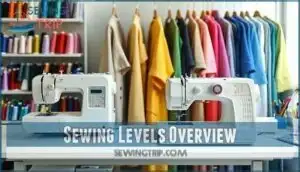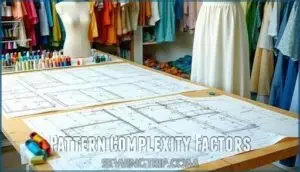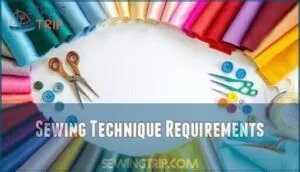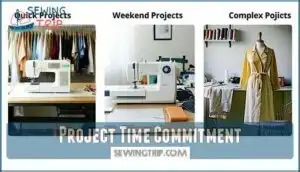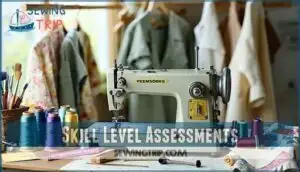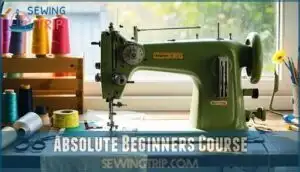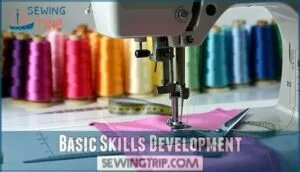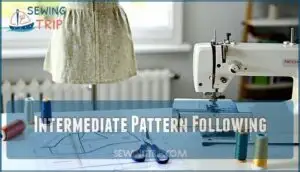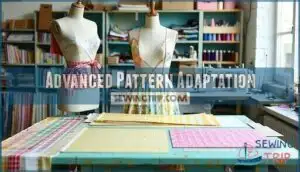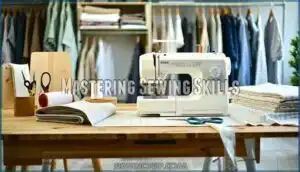This site is supported by our readers. We may earn a commission, at no cost to you, if you purchase through links.
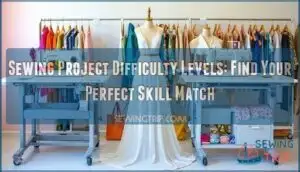
Beginners should start with simple straight seams on cotton fabric—think tote bags or pillowcases.
You’ll need basic machine operation and measuring skills.
Intermediate sewers can tackle fitted garments with zippers and buttonholes, while advanced projects involve complex construction like custom jackets or evening gowns.
Your comfort with pattern reading, fabric behavior, and troubleshooting determines your level.
Don’t jump ahead too quickly—there’s nothing worse than a half-finished disaster haunting your sewing room.
The secret lies in understanding which specific techniques separate each level.
Table Of Contents
Key Takeaways
- You’ll avoid frustration and build confidence by matching projects to your current skill level rather than jumping ahead too quickly—start with straight seams on cotton before tackling complex fitted garments
- You can assess your skill level by evaluating your comfort with pattern reading, fabric behavior, and troubleshooting—beginners need guidance for every step while intermediates handle darts and zippers independently
- You’ll progress faster by choosing projects that stretch your abilities just slightly beyond your comfort zone—master one technique completely before rushing to the next
- You shouldn’t let fabric choice sabotage your success—cotton and cotton blends forgive mistakes while delicate silks and stretchy materials demand specialized techniques and experience
Sewing Skill Levels
You’ll need to match your current sewing abilities with the right project difficulty to avoid frustration and build confidence steadily.
Choose projects that stretch your skills just enough to grow without overwhelming your current abilities.
Understanding where you fit on the skill spectrum helps you choose patterns that challenge you just enough without overwhelming your current capabilities, and this understanding is key to steady confidence.
Total Beginner Characteristics
Where do you start when you’ve never touched a sewing machine?
As a total beginner, you’re learning machine threading and mastering straight seams on simple fabrics like cotton.
You’ll need pattern guidance for basic techniques, starting with beginner sewing projects like pillowcases or tote bags.
These easy sewing patterns build your confidence through quick sewing projects and simple sewing tutorials focused on confidence building fundamentals.
Starting with a simple tote bag helps you learn essential sewing skills.
Confident Beginner Traits
Most confident beginners have completed 2-3 garments and mastered Pattern Comprehension for basic commercial patterns.
You’ve developed Seam Mastery with straight and curved seams while maintaining consistent seam allowances.
Your Project Selection focuses on beginner-friendly designs that build sewing confidence, including Smart Fabric Choices such as stable wovens and simple knits.
You’re ready for Skill Expansion into darts and basic closures, understanding sewing project difficulty levels and pattern difficulty ratings perfectly, and these individuals often exhibit a readiness to tackle challenges beyond basic shapes.
Easy Intermediate Requirements
You’re ready to tackle more complex projects that go beyond basic seaming.
Easy intermediate requirements center on mastering darts and fastenings while building confidence through skill consolidation. These intermediate sewing projects challenge you with increased pattern difficulty rating without overwhelming your abilities.
- Master fundamental shaping techniques – Learn darts, basic buttonholes, and standard zippers to create fitted garments that actually look professional
- Handle pocket insertion and waistband application – These structural elements separate beginner projects from polished, wearable pieces
- Navigate moderate project complexity – Work with patterns featuring multiple pieces, facings, and simple gathering while maintaining accuracy.
Proper tension adjustment is key for achieving clean lines and a professional finish.
Intermediate Sewer Expectations
At the intermediate level, you’re making clothing that fits properly and looks polished.
You confidently handle Pattern Modifications like adjusting sleeve length or taking in seams.
Fitting Challenges become puzzles you can solve, while Fabric Choices expand beyond cotton basics.
Technique Refinement means your seams lie flat and corners look crisp.
Each intermediate sewing project builds your sewing skills systematically.
| Skill Area | What You Can Do | Current Goals |
|---|---|---|
| Pattern Work | Follow complex instructions, make basic alterations | Master fitting adjustments |
| Construction | Insert zippers, sew buttonholes, attach collars | Perfect seam finishes |
| Fabric Handling | Work with knits, lightweight wovens, structured fabrics | Tackle challenging materials |
Advanced Sewer Qualifications
You’ve mastered the basics and now you’re ready to tackle the most challenging sewing projects.
Advanced sewers combine years of experience with specialized knowledge that sets them apart from the crowd.
Here’s what qualifies you as an advanced sewer:
- Pattern Creation – You draft original patterns and modify existing ones with confidence
- Couture Techniques – Hand-finished seams and invisible construction methods are second nature
- Fabric Versatility – Silks, chiffons, and stretch materials don’t intimidate you anymore
- Teaching Skills – You can explain complex sewing concepts to others clearly
Your advanced sewing skills let you handle any challenging sewing project.
Whether it’s tailoring expertise for structured jackets or couture sewing for evening wear, you’ve got the technical chops to make it happen.
Sewing Levels Overview
You’ll discover that sewing patterns use different rating systems to help match projects with your current abilities.
These levels range from "Curious" for complete beginners to "Couture" for advanced sewers, with each category clearly defining what skills you’ll need to succeed.
Curious Level Description
You’re an absolute beginner who owns a sewing machine but rarely touches it. Simple patterns feel overwhelming, and you need guidance for every step.
Machine basics like threading and winding bobbins still require concentration. Your first project should be straightforward—think pillowcases or tote bags.
These difficulty levels exist because everyone starts somewhere, and sewing challenges become manageable with practice. To get started, you’ll want to master essential stitches for basic projects.
Capable Level Expectations
At the capable level, you’ve moved beyond basic machine threading and can tackle more ambitious projects with confidence.
Your pattern familiarity extends to understanding layout instructions and fabric grain lines.
You’re comfortable with fundamental machine functions like adjusting stitch length and using different presser feet.
This intermediate stage focuses on skill reinforcement through consistent project selection that challenges without overwhelming, allowing you to distinguish between beginner and advanced difficulty levels, choosing patterns that build your sewing experience systematically with confidence.
Confident Level Requirements
You’ve reached the confident level when sewing patterns feel like reading your favorite recipe.
At this stage, you’re an advanced beginner ready to tackle more complex garment construction with steady hands and growing expertise.
Here’s what defines confident-level sewing:
- Pattern Comprehension – You read sewing patterns like a roadmap, understanding symbols and construction steps
- Seam Mastery – Your straight and curved seams are consistent, with proper tension control
- Pocket Insertion – You can add in-seam pockets without breaking a sweat
- Fastening Application – Zippers, buttons, and snaps become your trusty companions
Your dart techniques are improving, and sewing fit adjustments don’t intimidate you anymore.
You’re building confidence with each finished project.
Cocky Level Characteristics
You’ve developed Intuitive Sewing skills that make patterns feel like puzzles you solve effortlessly.
Direction Independence comes naturally—you rarely need instructions and own multiple machines with Machine Mastery.
Pattern Hacking excites you as you confidently make Confident Alterations without hesitation.
Your sewing intuition guides complex projects, showcasing true sewing expertise and proficiency that intimidates newer sewers.
Couture Level Qualifications
Mastery reaches its pinnacle when you’ve transcended conventional sewing boundaries.
You draft custom patterns from scratch, execute advanced sewing techniques like hand-rolled hems and bound buttonholes, and handle luxury fabrics with expertise.
Complex projects involving tailoring techniques, structural boning, and intricate embellishments become your specialty.
Professional results distinguish every garment you create through fastidious craftsmanship.
Sewing Project Difficulty
When you’re choosing your next sewing project, understanding difficulty levels helps you pick something that matches your current skills without leaving you frustrated halfway through.
The complexity depends on several factors like pattern intricacy, fabric behavior, required techniques, and how much time you’re willing to invest in learning new skills.
Pattern Complexity Factors
Pattern complexity isn’t just about piece count—it’s about the sewing learning curve you’ll face. Complex sewing patterns demand multiple skills simultaneously, from interpreting detailed pattern markings to executing advanced garment construction techniques.
- Piece count matters: Patterns with 15+ pieces challenge even experienced sewers with assembly logistics
- Pattern markings multiply: Advanced designs feature intricate notches, darts, and grainlines requiring careful transfer
- Seam types vary: French seams, flat-felled edges, and bias binding appear in 60% of intermediate patterns
- Fitting adjustments expected: Complex sewing patterns assume you’ll modify for proper fit independently
- Pattern alterations required: Sewing detail increases when projects need significant customization for sewing project selection success. These projects often require sewers to source intricate pattern designs.
Fabric Type Considerations
Fabric choice dramatically impacts your project’s difficulty level.
Cotton and cotton blends offer forgiveness for beginners, while stretchy lycra demands specialized techniques and needles.
Delicate fabrics like chiffons and silks require gentle handling and sharp tools.
Heavy fabrics test your machine’s strength, and fabric drape affects how garments hang.
Consider fiber content and weave structure—they’ll make or break your sewing success.
Selecting appropriate fabrics for beginners can substantially ease the learning process.
Sewing Technique Requirements
Beyond fabric choice, you’ll need to master specific techniques that match your project’s complexity. Each skill builds on the last, creating a roadmap for your sewing journey.
Your technique requirements include:
- Seam finishes – French seams for delicate fabrics, serged edges for stretch materials
- Fastening methods – Hand-sewn buttons for beginners, invisible zippers for advanced projects
- Pocket insertion – Simple patch pockets versus complex welt pocket construction
- Waistband application – Basic elastic waistbands progress to fitted, structured waistbands with interfacing
To achieve professional results, consider exploring different types of edge finishes. Collar construction and sewing technique refinement separate intermediate from advanced sewers, requiring precision and patience.
Project Time Commitment
Time commitments vary dramatically across sewing projects.
Quick Projects like tote bags take 2-4 hours, while Weekend Projects such as simple dresses require 8-12 hours.
Complex Projects like custom jackets demand 40+ hours.
Breathability and comfort are important considerations for garments that will be worn frequently.
Smart Time Management and Batch Sewing help maximize your sewing practice and accelerate sewing progress.
| Project Type | Time Range | Examples |
|---|---|---|
| Quick Projects | 2-4 hours | Tote bags, pillowcases, simple skirts |
| Weekend Projects | 8-12 hours | Basic dresses, pajama sets, lined jackets |
| Complex Projects | 40+ hours | Custom coats, evening gowns, structured blazers |
Skill Level Assessments
Honest skill identification starts with matching your abilities to project demands. Don’t let ego drive your choices—you’ll end up frustrated with half-finished disasters.
- Proficiency evaluation: Can you sew straight seams consistently and understand basic pattern markings?
- Level prerequisites: Have you mastered buttonholes, zippers, and simple alterations before tackling complex garments?
- Assessment methods: Test yourself on sample fabric scraps before committing to expensive materials
- Realistic expectations: Choose projects one skill level above your comfort zone, not three levels ahead
Sewing Class Difficulty
You’ll find sewing classes range from absolute beginner courses that teach basic machine threading to expert-level workshops covering couture techniques and advanced fitting.
Most schools use a 1-10 difficulty scale, where level 1 covers zipper insertion and buttonholes, while level 10 tackles pattern drafting and complex tailoring projects.
Absolute Beginners Course
You’ll start your sewing journey with machine basics, learning to thread your needle and wind bobbins.
Absolute beginners courses cover fabric choices, helping you pick cotton over tricky materials like silk.
You’ll practice simple seams on straight lines before curves, and project selection focuses on beginner-friendly sewing like tote bags or pillowcases.
Tool familiarity comes naturally as you learn to sew through hands-on practice.
Basic Skills Development
Once you’ve got machine basics down, you’re ready to build solid foundational skills.
This stage focuses on stitch consistency and seam accuracy—two pillars that’ll make or break your beginner-friendly sewing projects.
You’ll develop tool familiarity while mastering fabric handling techniques that transform wobbly attempts into confident creations.
- Machine basics: Threading, tension adjustment, and proper needle selection for different fabrics
- Stitch consistency: Maintaining even seam allowances and straight lines through practice
- Fabric handling: Learning to guide material smoothly without pulling or bunching
- Seam accuracy: Creating clean, professional-looking connections that won’t unravel
Intermediate Pattern Following
Following sewing patterns becomes second nature when you’ve mastered the basics.
You’ll confidently interpret pattern markings, understand construction sequences, and tackle fitting challenges with ease.
Your sewing skill development shows through clean seam finishes and precise fabric choices.
Understanding essential stitches is also key to mastering patterns.
Pattern instructions make sense now, letting you focus on sewing techniques rather than decoding symbols.
Advanced Pattern Adaptation
You’ve mastered basic patterns, but now you’re ready to make them truly yours. Advanced Pattern Adaptation means transforming existing designs through Fit Alterations, Style Personalization, and Creative Patternmaking techniques.
Here’s what you’ll tackle:
- Complex Adjustments – Reshaping armholes and necklines for perfect fit
- Design Modifications – Adding princess seams or changing silhouettes entirely
- Advanced grading – Scaling patterns between multiple sizes seamlessly
- Creative combining – Merging elements from different patterns into one garment
This level requires solid understanding of garment construction and body measurements.
Expert Level Couture Techniques
Expert couture techniques represent the pinnacle of sewing mastery.
You’ll master complex fitting through multiple toiles, hand stitching that comprises 80% of construction, and pattern drafting from scratch.
Fabric manipulation becomes second nature as you work with silk and organza.
Understructures like boning require precision installation.
These very advanced skills create couture garments demanding 100+ hours and absolute perfection in sewing custom garments.
Mastering Sewing Skills
You’ll master sewing by setting realistic goals that match your current abilities and gradually tackling more complex projects.
Celebrating each small win—from your first straight seam to perfectly installed zipper—builds the confidence you need to keep improving and eventually create professional-quality garments.
Setting Realistic Goals
Your sewing journey needs realistic checkpoints, not impossible leaps. Smart sewers match their ambitions to their current abilities on the sewing difficulty scale. Start with skill-based projects that stretch you slightly without causing frustration.
Smart sewers stretch just beyond their comfort zone without diving into disaster.
- Choose achievable timelines – Budget twice the time you think you’ll need for new techniques
- Match fabric choices to your comfort zone – Save silk for after you’ve conquered cotton
- Define clear project scope – One new skill per project prevents overwhelm
- Gather learning resources beforehand – Videos and tutorials should be bookmarked, not searched mid-seam
- Track sewing skill progression – Document what works to build your personal sewing proficiency levels
Remember, even experienced sewers started with wobbly seams. Your sewing skills assessment should focus on growth, not perfection. Each project complexity level you conquer becomes your new baseline.
Celebrating Small Victories
Once you’ve set achievable goals, take time to acknowledge progress along your sewing journey.
Every completed seam deserves recognition. Document your sewing achievement with photos or a project journal. Share successes with fellow sewers online or in person.
These moments of positive reinforcement fuel your sewing motivation and inspire others to pursue their own creative paths.
| Milestone | Reward Ideas | Share Method |
|---|---|---|
| First straight seam | New fabric scissors | Social media post |
| Completed garment | Quality thread set | Sewing group show |
| Perfect buttonhole | Pattern shopping | Progress photos |
Building Confidence Progressively
Your journey’s rhythm matters more than speed when tackling beginner-friendly sewing projects.
Each skill milestone builds the foundation for sewing success, turning small wins into lasting confidence through positive reinforcement and community support.
- Master one technique completely before rushing to the next—your future self will thank you
- Document your sewing achievement progress with photos that show how far you’ve traveled
- Connect with fellow sewers who understand the joy of conquering easy DIY sewing fears
- Celebrate every perfectly straight seam like it’s your personal sewing victory dance
Overcoming Common Challenges
While confidence builds your skills, real-world sewing problems test your patience. Tension issues create loose or tight stitches that ruin seams. Fabric slippage makes cutting inaccurate. Pattern interpretation confuses even experienced sewers.
Don’t panic when mistakes happen—they’re learning opportunities disguised as frustrations.
| Common Challenge | Quick Solution |
|---|---|
| Seam Puckering | Reduce presser foot pressure, check needle size |
| Zipper Insertion | Baste first, use zipper foot, go slow |
| Thread Breaks | Check tension, replace old thread, clean machine |
These sewing difficulties aren’t roadblocks—they’re stepping stones. Each problem you solve makes the next project easier. Practice on scraps before tackling your good fabric. Remember, even master sewers once struggled with these same sewing challenges.
Achieving Sewing Mastery
Through consistent practice and skill refinement, you’ll master advanced techniques that transform your sewing.
Creative exploration becomes second nature as you tackle complex projects with confidence.
Here’s your mastery roadmap:
- Technique refinement – Perfect those tricky details that separate good from great
- Sewing complexity – Embrace challenging patterns that push your boundaries
- Teaching others – Share knowledge to solidify your own understanding
Mastery isn’t a destination—it’s continuous growth through deliberate practice and creative exploration.
Frequently Asked Questions (FAQs)
Why do I need a pattern difficulty rating?
Like choosing the right tool for the job, pattern difficulty ratings help you pick projects that match your skills. They prevent frustration from tackling advanced techniques before you’re ready.
Are beginner & confident patterns becoming quick sews?
You’re noticing a trend where beginner and confident patterns are becoming quicker to complete.
Pattern designers are streamlining construction methods, reducing steps, and focusing on simpler techniques that deliver satisfying results faster, which is a key aspect of the trend where quicker completion is observed.
What is the difference between beginner and advanced sewing patterns?
Beginner patterns feature straight seams, simple construction, and basic techniques like hemming.
You’ll work with forgiving fabrics and clear instructions.
Advanced patterns demand precise fitting, complex details like welt pockets, tailoring techniques, and challenging fabrics requiring specialized skills.
How many sewing patterns do I need to be a beginner?
You’ll typically complete 2-3 sewing patterns to move from total beginner to confident beginner. Start with simple projects like tote bags, then progress to basic garments like skirts or tops.
How can I improve my sewing skills?
Start with simple projects like tote bags and pillowcases to build foundational skills.
Practice consistently, take classes or follow online tutorials, and gradually tackle more challenging patterns.
Don’t rush—master each technique before advancing to complex garments.
What is a beginner sewing course?
Even if you’ve never touched a sewing machine, you’re ready to learn.
A beginner sewing course teaches you threading machines, sewing straight seams, and basic techniques through hands-on practice with simple projects.
What is the most difficult thing to sew?
Complex custom garments like men’s suit jackets challenge you with intricate construction, precise fitting, structured canvas work, and advanced techniques requiring years of experience to master properly.
Are there different difficulties of sewing patterns?
Of course you’d think all patterns are created equal!
Sewing patterns range from beginner-friendly straight seams to advanced couture techniques requiring years of experience, precise fitting skills, and specialized knowledge of complex construction methods.
What are the big 4 in sewing?
You’ll find these major pattern companies, Simplicity, Butterick, McCalls, and Vogue, throughout fabric stores and online.
They’re called the Big 4 because they’ve dominated commercial sewing patterns for decades, offering everything from beginner-friendly basics to advanced couture designs at affordable prices.
How do fabric weights affect project difficulty?
Fabric weight acts like a river’s current—heavier materials resist your needle’s flow, demanding stronger techniques.
Lightweight fabrics slip and fray easily, while heavy ones challenge your machine’s power.
You’ll wrestle with drape, handling, and finishing methods that transform simple patterns into complex puzzles.
Conclusion
Mastering sewing project difficulty levels transforms your creative chaos into organized success.
You’ll waste thousands of hours wrestling with impossible patterns if you ignore skill matching.
These difficulty frameworks guide your journey from wobbly straight seams to couture masterpieces.
Start where you’re comfortable, then stretch gradually.
Your sewing room deserves finished projects, not abandoned disasters.
Trust the process, celebrate small wins, and watch your confidence soar with each completed creation.
- https://crazylittleprojects.com/sewing-for-beginners-learn-to-sew/
- https://www.seamwork.com/sewing-tutorials/how-to-sew-clothes-total-beginner
- https://arrowsewing.com/blog/sewing-101-a-beginners-guide-to-sewing-basics/
- https://icansewthis.com/things-i-wish-i-knew-when-i-started-sewing/
- https://beginnersewingprojects.com/how-to-sew-for-beginners/


